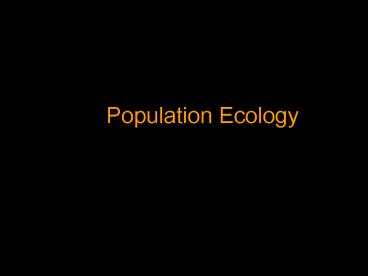Population Ecology PowerPoint PPT Presentation
1 / 17
Title: Population Ecology
1
Population Ecology
2
Population Demographics
- Demographics are the various characteristics of a
population including, Population Size, Age
Structure, Density, and Distribution - Demographics allow one to determine the
ecological and evolutionary relationships between
various species populations
3
Population Size
- Population size is represented by the variable N
- Peterson Population Estimating is a common method
for determining Population Size (N) - Population Growth can be represented as either
exponential or logistic
4
Peterson Population Estimate
- The Peterson Estimate is a mark and recapture
method divided into two sample periods (Precensus
and Census)
5
Peterson Estimate Calculation
- During the Precensus, individuals are captured
and marked (M) - During the Census, individuals are captured, some
of which have marks (R) and some which do not.
The total captured on the Census equals (n). - Peterson Estimate (n x M) / R
6
Peterson Estimate Assumptions
- Assumes that no births, death, immigration, or
emigration occur during the census period - Assumes that mark are permanent and do not
adversely effect the organism
7
Population Growth
- Factors that increase population size include
births an immigration - Factors that decrease population size include
deaths and emigration - The Net Reproductive Rate (r)
- r (births immigration) (deaths
emigration)
8
Exponential Growth
- Population Growth (G)
- G r x N
- New Population Value (Nx)
- N1 (r x N) N
- N2 (r x N1) N1
9
Logistic Growth
- Population Growth (G)
- G r x N (K-N) / K)
- New Population Value (Nx)
- N1 (r x N (K-N) / K)) N
- N2 (r x N1 (K-N1) / K)) N1
10
Age Structure
- Age structure is the number of individuals in
each of several to many age categories
11
Population Density
- Population Density is the number of individuals
in a specified area of a habitat
12
Population Distribution
- Population Distribution is the general pattern in
which individuals or a population are dispersed
through a specified area - Clumped, Uniform, or Random
13
(No Transcript)
14
(No Transcript)
15
Survivorship Curves
- Type I
- High Survivorship until fairly late in life, then
a large increase in death
16
- Type II
- Fairly constant death rate at all ages
17
- Type III
- Low survivorship early in life due to high death
rate but if they reach adulthood they survive
long

